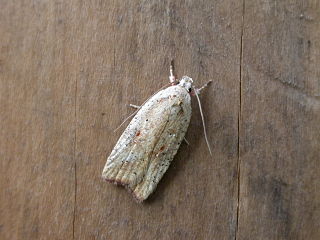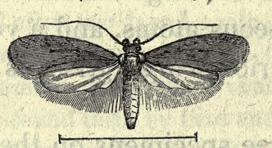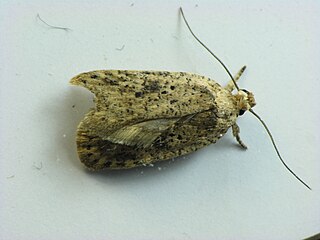Clarke's vole is a species of rodent in the family Cricetidae. It is found only in China.

Agonopterix ocellana is a species of moth of the family Depressariidae. It is found in Europe and was first described by Johan Christian Fabricius in 1775

The gorse tip moth is a smallish moth species of the family Depressariidae.
Trochocarpa clarkei, commonly known as lilac berry, is a rare flowering plant in the family Ericaceae. It is endemic to sub-alpine areas of Victoria in Australia. It is a shrub which grows to around 30 cm high. The flowers are maroon with a greenish base. The fruits, which appear in autumn, are about 8 mm in diameter. These are eaten by small mammals and birds. The species occurs in subalpine areas of the southern highlands, often in association with Eucalyptus pauciflora.

Agonopterix is a moth genus of the superfamily Gelechioidea. It is placed in the family Depressariidae, which was often – particularly in older treatments – considered a subfamily of the Oecophoridae or included in the Elachistidae.

Agonopterix rotundella is a moth of the family Depressariidae and is found in most of Europe. It was first described from moths found in Surrey, England by the entomologist John Douglas in 1846.
Agonopterix antennariella is a moth in the family Depressariidae. It was described by John Frederick Gates Clarke in 1941. It is found in Washington, British Columbia and western Greenland.
Agonopterix arnicella is a moth in the Depressariidae family. It was described by Walsingham in 1881. It is found in North America, where it has been recorded from Alberta, Ontario, Washington, Oregon and California.
Agonopterix lythrella is a moth in the family Depressariidae. It was described by Walsingham in 1889. It is found in North America, where it has been recorded from Illinois, Maine, Maryland, Massachusetts, Michigan, Minnesota, New Brunswick, New Hampshire, New York, North Carolina, Nova Scotia, Ohio, Ontario and Saskatchewan.
Agonopterix walsinghamella, or Walsingham's agonopterix moth, is a moth in the family Depressariidae. It was described by August Busck in 1902. It is found in North America, where it has been recorded from the north-eastern United States and Canada.
Agonopterix curvilineella, the curved-line agonopterix moth, is a moth in the family Depressariidae. It was described by William Beutenmüller in 1889. It is found in North America, where it has been recorded from Illinois, Indiana, Kentucky, Maine, Maryland, Massachusetts, Michigan, Minnesota, Mississippi, New Brunswick, New York, Ohio, Ontario, Quebec, Tennessee, West Virginia and Wisconsin.
Agonopterix deltopa is a moth in the family Depressariidae. It was described by Meyrick in 1935. It is found in China and Japan.
Agonopterix hesphoea is a moth in the family Depressariidae. It was described by Ronald W. Hodges in 1975. It is found in North America, where it has been recorded from Texas.
Agonopterix jezonica is a moth in the Depressariidae family. It was described by Matsumura in 1931. It is found in Japan (Honshu).
Agonopterix sumizome is a moth in the family Depressariidae. It was described by K. Fujisawa in 1985. It is found in Japan.
Agonopterix yomogiella is a moth in the family Depressariidae. It was described by Saito in 1980. It is found in Japan.
Agonopterix agyrella is a moth in the family Depressariidae. It was described by Rebel in 1917. It is found in Central Asia (Tannuola).
Agonopterix pullella is a moth in the Depressariidae family. It was described by Hannemann in 1971. It is found in Mongolia.
Agonopterix ramosella is a moth in the family Depressariidae. It was described by Stainton in 1867. It is found in Armenia and the Alay Mountains.
Agonopterix tabghaella is a moth in the family Depressariidae. It was described by Hans Georg Amsel in 1953. It is found in North Africa.





